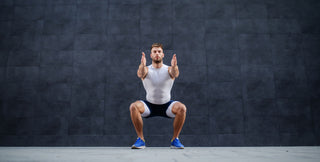Since it’s used in almost every training regimen and has innumerable variations including weighted ones, the squat is one of the best exercises to build and test your strength. However, unluckily, many people struggle to perform it pain-free.
The pain usually you feel while doing squats is not because of training, rather it’s from sitting. Sitting most of your time causes physiological problems and most of them appear when you try to squat.
Table of Contents
7 Practical Tips to Do Squats in a Pain Free Way
If you feel pain while you squat, it’s possibly because you may have a weak core or weak glutes, a tight back or even tight hips. Here are some useful tips to help you do pain-free squats:
Tip # 1: Avoid Excessively Wide Stances
One of the main reasons for your pain while you squat could be the excessively wide stance. The foundation for a solid squat is based on foot placement, and it must be suitable for individuals for maximum safety and performance.
Avoiding an excessively wide stance or a narrow stance can help you do squats without any pain. Generally speaking, many people will feel more relaxed with the shoulder-foot width apart. Experts call it a “moderate” width stance. As squats are used for leg workouts, core workouts and even back and shoulder workouts, you need to have a stance that can work them all at once.
Tip # 2: Build Up Your Cores
This is one of the key reasons for a painful squat session. Having weak cores will result in weak and painful squat sessions.
To build your core, the best exercise is “stir the pot”. This exercise is performed by placing your forearms and elbows on a stability or medicine ball, in a plank position with a slight bend in your knees. Stir the pot by moving your elbows in a circular motion without moving your hips.
Tip # 3: Fire Up Your Glutes
You might have already understood that having strong glutes is essential for performing pain-free squats.
To do this, get involved in an exercise like the Glute Bridge. This exercise is done by lying on your back with your knees bent and neutral spine. Squeeze your glutes and lift up your hips in the air.
Moreover, the resistance can be increased by leaning your upper body against a bench and adding a barbell or a weighted plate to your hips. However, don’t let your hips move up and down, or side to side throughout the movement. Ensure that you get the most out of your leg workouts this way.
Tip # 4: Press the Knee Out
This is one more important tip for a painless squat session. Try to press your knees outwards while performing the squat. Having your knees inwards will put more weight on your knees. However, if you keep the knees outward, it will bring more of your hips in the exercise and make it less stressful for the knees while making the squat more stable.
Tip # 5: Increase Your Squat Depth
Increasing the depth while you squat will help hips to move past your knees in-depth, enabling your glutes to help you get out of the depth position of your squat. The whole pressure remains on the knees if you perform the parallel or partial squat.
However, if you are unable to do this with the right technique, or your knee muscles are not helping you do this, move to the leg press or smith machine. These can be used to improve the strength of your knees with a great range of motions.
Tip # 6: Make Sure Your Feet Stay Planted
Make sure to keep your heels on the floor throughout the duration of your squat. Pay special attention to drive through your heels on the way back up. This will help fire up your posterior chain, the muscles in the back like hamstrings and glutes.
However, while focusing on driving through the heels, many people pick up their toes, making it hard to perform the squat correctly. You need to make sure that your entire foot stays on the ground firmly. Your big toe is actually very important in glute activation.
|
Related Reading: Some Simple Self-Care Tips and Tricks |
Tip # 7: Try the Low Bar Squat
Usually, the back squat involves the bar on the upper traps. This position is called the high bar squat. That can cause back pain.
Alternatively, you can try to move the bar lower down so it is in your posterior deltoid area. This change in the exercise will move your trunk forward and will shift the load from the knees to the hips.
However, practicing this position will put more pressure on the elbows and shoulders. Also, good flexibility is a must to do this exercise in the right way.
Takeaway
Whether you’re going for back or chest workouts, shoulder or leg workouts, or even back workouts, you need to get your squats right. Doing squats painlessly is not impossible. Just follow the above-mentioned tips and you are good to do pain-free squats. Moreover, reconsider your day-to-day routine and keep your knees away from unnecessary stressful positions.
READ MORE:
10 BEST MUSCLE BUILDING EXERCISES FOR CHEST
BEST BACK EXERCISES: GET PERFECT V-PHYSIQUE
THIS DUMBBELL LEG WORKOUT CAN INCREASE YOUR MASS IN LESS TIME
THE 10 BEST EXERCISES TO TRAIN YOUR SHOULDER MUSCLES AT THE GYM
"This article is originally posted on borntough.com, and borntough.com own the sole copyright on this article. If you read this article outside borntough.com, please report this website to the authority because they have stolen the content from borntough.com and violated borntough copyright"
